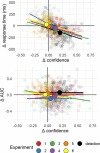Metacognitive asymmetries in visual perception
- PMID: 34676104
- PMCID: PMC8524176
- DOI: 10.1093/nc/niab025
Metacognitive asymmetries in visual perception
Erratum in
-
Erratum to: Stage 1 registered report: metacognitive asymmetries in visual perception and Stage 2 registered report: metacognitive asymmetries in visual perception.Neurosci Conscious. 2021 Dec 13;2021(1):niab046. doi: 10.1093/nc/niab046. eCollection 2021. Neurosci Conscious. 2021. PMID: 34912567 Free PMC article.
Abstract
Representing the absence of objects is psychologically demanding. People are slower, less confident and show lower metacognitive sensitivity (the alignment between subjective confidence and objective accuracy) when reporting the absence compared with presence of visual stimuli. However, what counts as a stimulus absence remains only loosely defined. In this Registered Report, we ask whether such processing asymmetries extend beyond the absence of whole objects to absences defined by stimulus features or expectation violations. Our pre-registered prediction was that differences in the processing of presence and absence reflect a default mode of reasoning: we assume an absence unless evidence is available to the contrary. We predicted asymmetries in response time, confidence, and metacognitive sensitivity in discriminating between stimulus categories that vary in the presence or absence of a distinguishing feature, or in their compliance with an expected default state. Using six pairs of stimuli in six experiments, we find evidence that the absence of local and global stimulus features gives rise to slower, less confident responses, similar to absences of entire stimuli. Contrary to our hypothesis, however, the presence or absence of a local feature has no effect on metacognitive sensitivity. Our results weigh against a proposal of a link between the detection metacognitive asymmetry and default reasoning, and are instead consistent with a low-level visual origin of metacognitive asymmetries for presence and absence.
Keywords: absence; metacognition; presence.
© The Author(s) 2021. Published by Oxford University Press.
Figures







References
-
- Albonico A, Furubacke A, Barton JJ. et al. Perceptual efficiency and the inversion effect for faces, words and houses. Vision Res 2018;153:91–7. - PubMed
-
- Aust F, Barth M. 2020. Papaja: Create APA Manuscripts with R Markdown. https://github.com/crsh/papaja (1 August 2021, date last accessed).
-
- Borchers HW (2019). Pracma: Practical Numerical Math Functions. https://CRAN.R-project.org/package=pracma (1 August 2021, date last accessed).
-
- Calder-Travis J, Charles L, Bogacz R. et al.. Bayesian confidence in optimal decisions 2020. 10.31234/osf.io/j8sxz. - DOI - PMC - PubMed
-
- Champely S. 2020. Pwr: Basic Functions for Power Analysis. https://CRAN.R-project.org/package=pwr (1 August 2021, date last accessed).
Publication types
Grants and funding
LinkOut - more resources
Full Text Sources
